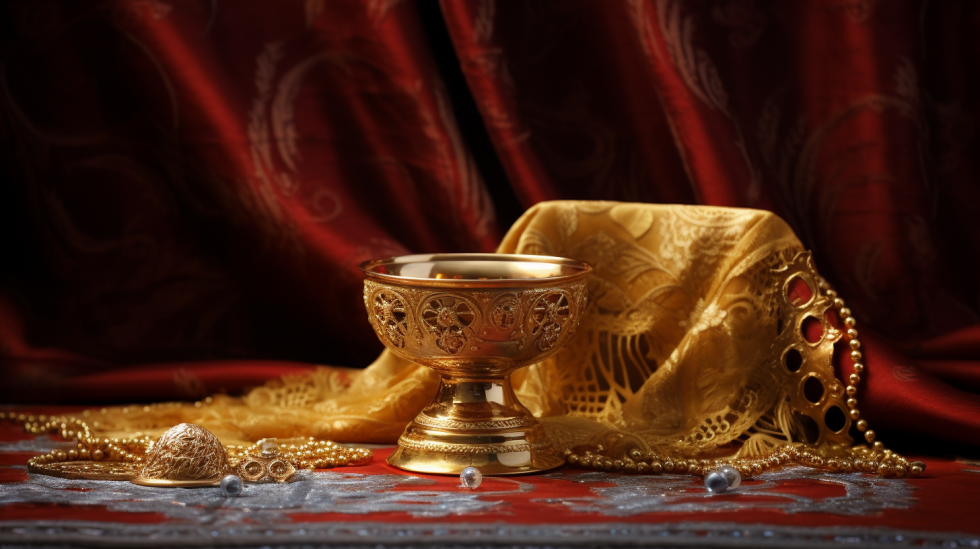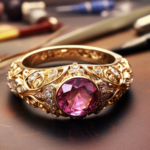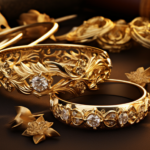Gold jewelry has been cherished and adorned by humanity for millennia. Its timeless allure, radiance, and malleability have made it not just a symbol of wealth but a work of art that transcends generations. The history of gold jewelry is a rich tapestry woven through cultures, civilizations, and centuries, reflecting the human desire for beauty and self-expression. In this exploration of the “History of Gold Jewelry,” we’ll embark on a journey through time, from the ancient civilizations that first discovered the luster of gold to the contemporary designs that grace runways and red carpets.

The Dawn of Gold Jewelry
Gold’s allure as a precious metal dates back thousands of years, to the dawn of human civilization. It was one of the first metals to be discovered, shaped, and used for adornment. Here’s a glimpse into the early chapters of gold jewelry history:
1. Ancient Egypt: The ancient Egyptians are renowned for their love of gold jewelry. Gold was believed to be the flesh of the gods, and it held profound religious and symbolic significance. Pharaohs and nobles adorned themselves with intricate gold jewelry, including necklaces, bracelets, earrings, and headdresses. Gold jewelry was often buried with the deceased to accompany them to the afterlife.
2. Ancient Mesopotamia: The Sumerians and Babylonians of ancient Mesopotamia crafted gold jewelry as early as 3000 BCE. These civilizations left behind treasures of gold necklaces, rings, and earrings, showcasing their craftsmanship and appreciation for the precious metal.
3. Ancient India: In the Indus Valley Civilization, which dates back to around 2500 BCE, gold jewelry was a symbol of wealth and status. Elaborate gold necklaces, bangles, and anklets have been unearthed in archaeological excavations.
4. Ancient Greece: Ancient Greeks celebrated the beauty of gold in their jewelry. They created intricate pieces featuring motifs inspired by mythology and nature. Gold wreaths, diadems, and filigree jewelry were worn by both men and women.
Gold Jewelry in the Roman Empire
The Roman Empire inherited a love for gold jewelry from its predecessors and elevated it to new heights of opulence and sophistication:
1. Roman Rings: Romans adored gold rings, which were worn as symbols of status and identity. Signet rings with engraved gemstones were used to seal documents and mark ownership.
2. Togas and Torques: Roman aristocrats draped themselves in gold jewelry, including torques and brooches. Togas were fastened with gold fibulae (clasps), and decorative gold pins adorned garments.
3. Earrings and Bracelets: Gold earrings and bracelets were popular among Roman women. Hoop earrings, stud earrings, and dangling earrings showcased various designs and gemstones.
4. Cameos and Intaglios: Gold jewelry often featured cameos and intaglios, carved gemstones set in gold, depicting portraits, scenes, and mythological figures.
The Medieval and Renaissance Periods
The Middle Ages and the Renaissance brought about distinct styles and symbolism in gold jewelry:
1. Medieval Ecclesiastical Jewelry: The Church played a significant role in the design and production of gold jewelry during the Middle Ages. Ecclesiastical jewelry included intricate crosses, chalices, and reliquaries adorned with gold and precious gems.
2. Medieval Personal Adornments: While the Church influenced jewelry design, medieval Europe also saw the development of personal adornments. Nobility and royalty wore gold crowns, tiaras, and necklaces that reflected their status and heraldic symbols.
3. Renaissance Revival: The Renaissance brought a revival of interest in classical art and culture. This period saw a resurgence of interest in ancient Roman and Greek designs, with gold jewelry featuring classical motifs and intricate craftsmanship.
Gold Jewelry in the Modern Era
The modern era witnessed a dynamic evolution in gold jewelry styles, influenced by changing fashion trends, technology, and cultural shifts:
1. Victorian Era: The Victorian era (1837-1901) saw a fascination with symbolism in jewelry. Sentimental and mourning jewelry, often crafted in gold, featured intricate designs with hidden meanings. Lockets, cameos, and mourning rings were popular.
2. Art Nouveau: The Art Nouveau movement (late 19th to early 20th century) brought a departure from traditional jewelry styles. Gold jewelry from this period often featured flowing, organic forms inspired by nature, with enamels and gemstones.
3. Art Deco: The Art Deco movement (1920s and 1930s) celebrated geometric shapes, bold colors, and architectural designs. Gold jewelry of this era showcased symmetrical patterns, bold lines, and a blend of precious metals.
4. Contemporary Gold Jewelry: Modern gold jewelry encompasses a vast range of styles, from minimalist and sleek designs to bold and avant-garde creations. Designers and artisans experiment with various alloys, gemstones, and innovative techniques to create jewelry that suits the tastes of diverse generations.
Cultural Significance of Gold Jewelry
Gold jewelry has held profound cultural significance throughout history and across different cultures:
1. Weddings and Marriage: Gold wedding bands are a universal symbol of love and commitment. In many cultures, couples exchange gold rings as a sign of their union.
2. Religious Significance: Gold jewelry often features prominently in religious rituals and ceremonies. It symbolizes purity, divinity, and the highest spiritual values.
3. Status and Wealth: Gold jewelry has long been a status symbol, signifying wealth, power, and social standing. Elaborate gold jewelry was reserved for the elite.
4. Tribal and Ethnic Identity: In many indigenous cultures, gold jewelry is a representation of tribal identity, heritage, and cultural traditions. It is often worn as a symbol of belonging to a specific community.
5. Protection and Superstition: Some cultures believe that wearing specific gold jewelry pieces, such as amulets or talismans, can provide protection from harm and bring good luck.
Modern Trends in Gold Jewelry
In contemporary fashion, gold jewelry remains a timeless choice that adapts to evolving tastes and styles. Here are some modern trends in gold jewelry:
1. Minimalism: Minimalist gold jewelry, characterized by clean lines and simplicity, has gained popularity. Pieces like delicate gold necklaces, stackable rings, and thin bangle bracelets offer a subtle yet elegant look.
2. Layering: Layering gold necklaces and bracelets has become a fashionable trend. This style allows for creativity and personalization, with wearers mixing and matching pieces to express their unique style.
3. Vintage and Antique Revival: Vintage-inspired gold jewelry, often featuring intricate filigree work and gemstone accents, has seen a resurgence. Antique pieces from different eras continue to captivate collectors and enthusiasts.
4. Sustainability: As environmental concerns grow, there’s a rising interest in sustainable and ethically sourced gold jewelry. Many designers and brands are committed to responsible sourcing and environmentally friendly practices in the production of gold jewelry.
5. Mixed Metals: Combining gold with other metals, such as silver or rose gold, offers a contemporary and eclectic look. Bicolored and tricolored jewelry pieces are on-trend.
6. Personalization: Customization and personalization are highly sought after in modern gold jewelry. Customers can engrave names, initials, or meaningful dates on their pieces, creating unique and sentimental jewelry.
7. Statement Pieces: Bold and oversized gold jewelry, including chunky necklaces, large hoop earrings, and statement rings, make a powerful fashion statement and are favored by fashion-forward individuals.
Gold Jewelry in the Digital Age
The digital age has transformed the way gold jewelry is designed, marketed, and purchased:
1. Online Shopping: E-commerce platforms have made it easier than ever to browse and buy gold jewelry from around the world. Customers can explore a vast array of designs and make purchases from the comfort of their homes.
2. Customization Apps: Jewelry designers and brands offer online tools that allow customers to customize and visualize their jewelry before making a purchase. This level of personalization enhances the shopping experience.
3. Social Media Influence: Social media platforms like Instagram and Pinterest have become influential in shaping jewelry trends. Designers and influencers showcase their creations, inspiring consumers with new ideas.
4. 3D Printing: Advances in 3D printing technology have enabled jewelry designers to create intricate and innovative gold jewelry designs that were once challenging to produce by traditional methods.
5. Ethical Sourcing: Increased awareness of ethical and sustainable practices has led to a growing demand for responsibly sourced gold jewelry. Many consumers prioritize buying from brands committed to responsible sourcing.
Famous Gold Jewelry Pieces
Throughout history, certain gold jewelry pieces have captured the world’s attention and become iconic symbols of beauty, craftsmanship, and heritage. Here are a few famous examples:
1. The Hope Diamond: While not entirely gold, the Hope Diamond is a renowned gemstone set in a gold and platinum necklace. This deep blue diamond has a storied history and is considered one of the world’s most famous jewels.
2. The Cartier Panther Bracelet: This exquisite gold bracelet, designed by Cartier, features a panther with emerald eyes and onyx spots. It has been worn by celebrities and royalty, making it a symbol of luxury and elegance.
3. The Fabergé Eggs: Created by the House of Fabergé, these ornate eggs are crafted from gold and adorned with gemstones and enamel. They are masterpieces of Russian jewelry artistry, with each egg telling a unique story.
4. The Crown Jewels: The British Crown Jewels, including the Imperial State Crown and the St. Edward’s Crown, are adorned with numerous gold and gemstone pieces. These historic jewels are worn during important royal ceremonies.
5. The Oscars Statuette: The Oscar statuette, awarded at the Academy Awards, is made of gold-plated bronze. It is an iconic symbol of achievement in the film industry.
The Allure of Gold Jewelry
The allure of gold jewelry endures because it encompasses both intrinsic and extrinsic value. It combines the rarity and purity of gold with the artistry and craftsmanship of jewelry design. Here are some of the enduring reasons behind the enduring appeal of gold jewelry:
1. Intrinsic Value: Gold is a precious metal with intrinsic value, making it a reliable investment and a symbol of wealth.
2. Timelessness: Gold jewelry transcends fashion trends and remains relevant through the ages.
3. Emotional Significance: Gold jewelry often carries sentimental value, passed down through generations as heirlooms.
4. Self-Expression: Gold jewelry allows individuals to express their style, personality, and cultural heritage.
5. Craftsmanship: The artistry and skill involved in creating gold jewelry make each piece a work of art.
Conclusion: A Legacy of Beauty
The history of gold jewelry is a testament to humanity’s enduring love for beauty, craftsmanship, and self-expression. From the lavish adornments of ancient Egyptian pharaohs to the sleek and modern designs of today, gold jewelry continues to captivate hearts and minds worldwide.
As we celebrate this legacy of elegance and heritage, we are reminded that gold jewelry is not just a reflection of personal style but a bridge between cultures, eras, and generations. It connects us to our ancestors, to the artisans who meticulously craft each piece, and to the timeless allure of a metal that has fascinated and inspired humanity for millennia.
So, whether it’s a delicate gold necklace passed down from your grandmother or a contemporary statement piece that complements your ensemble, gold jewelry carries with it a legacy of beauty and a promise of enduring elegance for generations to come.



